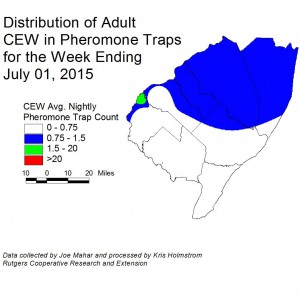Sweet Corn
We are between European corn borer (ECB) adult generations at this time. Only scattered individuals are being captured throughout NJ (see ECB map). ECB infestations are still present in some sweet corn plantings, but whorl stage corn is now largely free of ECB injury.
As always, consider treating when the number of infested plants in a 50 plant sample exceeds 12%. Any planting remaining at or above threshold as it proceeds to full tassel should be treated, as this is the last stage at which ECB larvae will be exposed and vulnerable to insecticidal sprays.
See the 2015 Commercial Vegetable Recommendations Guide for insecticide choices.
| The highest nightly ECB catches for the previous week are as follows: | ||
| Allamuchy 1 | Denville 1 | Sparta 1 |
| Beckett 1 | Downer 1 | Woodstown 1 |
| Belvidere 1 | East Vineland 1 | |
| Clinton 1 | Pedricktown 1 | |
There has been little change in catches of corn earworm moths (CEW) in blacklights this past week. Overall activity is quite low, and is primarily focused in the Gloucester-Salem County area (see CEW Map).
| The highest nightly CEW blacklight trap catches for the previous week are as follows: | ||
| Crosswicks 1 | Elm 1 | |
| Downer 1 | Tabernacle 1 | |
| East Vineland 1 | Woodstown 1 | |
The limited CEW pheromone trap network in the southern counties has captured only a few adults over the past week. Western Salem County has the highest activity, with very low activity elsewhere (see CEW pheromone map). With many sweet corn plantings now in silk, it is critical that growers monitor local CEW moth numbers. At present, reasonably light silk spray schedules should be adequate to limit CEW injury as well as to prevent ear damage from ECB larvae that already inhabit the stalks.
| The highest nightly CEW pheromone trap catches for the previous week are as follows: | ||
| Pedricktown 3 | Springdale 1 | |
| Elm 2 | Woodstown 1 | |
For sinking sweet corn, the following spray schedules are warranted.
Silking Spray Schedules*:
South – 6 days
Central – 6-7 days
North – 6-7 days
Low level fall armyworm (FAW) infestations continue to appear throughout NJ. These infestations are very low, and remain limited to smaller whorl stage plantings. Very few FAW moths have been captured in the region, so the threat of increased infestations in the near term seems low. However, this pest can be devastating to small corn plants. Fields down to seedling stage should be scouted weekly for signs of infestation.
Sap Beetle
With many plantings now in silk, and relaxed silk spray schedules due to low CEW numbers, growers should be alert to the possibility of sap beetle infestations in corn ears. Sap beetles (see photo) often feed on pollen prior to entering ears, and may be found where pollen gathers in leaf axils. If the particular sweet corn variety has loose tip cover, or the ear is protruding past the end of the husk, sap beetles will find easy entry. If sap beetles are found in plantings as they begin to silk, and tip cover is not good, or the variety has a history of poor cover, consider increasing the silk spray schedule by a day. Consult the 2015 Commercial Vegetable Recommendations Guide for insecticide choices.
Peppers
No pepper weevils have been caught in the past week at any of the trap sites. Reaching July 1 with no known infested fields is a good sign that we may escape this growing season with very few infestations. Typically, later season infestations show up in mid-August through mid-September. Trapping will continue through the rest of the growing season.
Brown Marmorated Stink Bug (BMSB)
Only a few individual BMSB were captured in NJ blacklight traps this past week. These catches are too low to create a map.
Cole Crops
IPM personnel have found increasingly heavy imported cabbageworm (ICW) infestations in all types of cole crop plantings this past week. It is critical that growers check fields at least weekly for signs of caterpillar infestations. Be sure to check inner leaves for indications of fresh feeding.
Pumpkins and Winter Squash
These crops are now established in many areas. It is important to monitor frequently for the presence of striped cucumber beetles at this time, particularly if the seed was not purchased pre-treated with an insecticide for cucumber beetle. Check 5 consecutive plants each in 10 random locations. Examine upper and lower surface of seed leaves for the presence of beetles. Consider treating if beetles are found at 5 or more sites. Heavy, but local infestations may be spot treated. Management of these pests will limit the loss of plants to the bacterial wilt disease that the beetles transmit.
A sentinel plot containing susceptible and resistant cucumber varieties, as well as muskmelons, watermelons, acorn and butternut squash and pumpkins is now established at the Snyder Research and Extension Farm in Hunterdon County. The purpose of this plot is to detect the presence of downy mildew (DM) in northern NJ. Any occurrence will be reported in this newsletter and will also generate an alert to all subscribers. For more information on the regional presence of DM as well as comprehensive, weekly forecasts, see the following website: http://cdm.ipmpipe.org/





